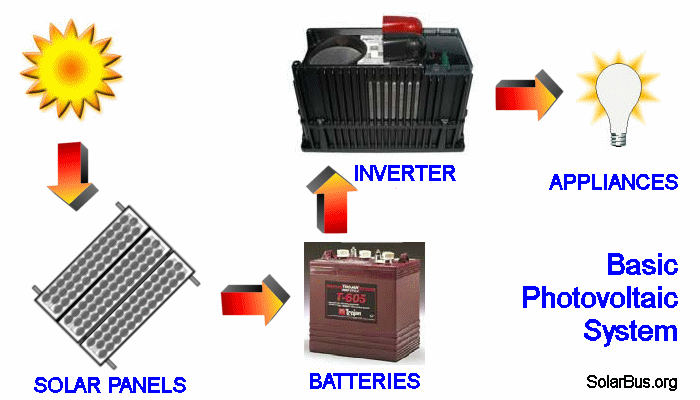 |
||||||||||||
|
|
||||||||||||
Solar Energy
BasicsJimmy Carter put solar panels on the White House roof, and offered tax credits to anyone who purchased solar energy systems. Ronald Reagan removed the solar panels from the White House and terminated the tax credits. Many people in the solar industry went out of business. The country was convinced that solar doesn't work.Well, we're here to tell you, and show you, that solar does work. Hopefully someday soon more people will realize this. Here are a couple myths and facts about solar energy:
Photovoltaics (PV) is the term for converting solar radiation into electricity. Photovoltaic cells, or panels, produce electricity (DC current) when exposed to sunlight. There are many manufacturers of large and small photovoltaic panels which are used to power small appliances like a calculator, to entire large homes. Many people think that we are waiting for a big scientific breakthrough for the use of photovoltaic panels to become feasible, but that is not true. The panels are extremely reliable and cost effective in many applications today. With more awareness and support from policy makers, solar energy could become a significant contributor to the nation's energy production without any advance in technology. Basics of a solar electric system click to enlarge A solar electric (PV) system can provide power for a single appliance, a house, or even a city. In each case, the components of the system and their functions are the same. Array - one or more solar (PV) panels that creates electricity when exposed to sunlight Batteries - used to store the energy created by the solar panels, so that power can be used when the sun isn't shining. The batteries also are there for times when more power is required than the solar panels are producing at that moment. Some systems do not use batteries. These are usually small systems of one appliance that only needs to run when the sun is shining, for example a pump or a fan. Batteries are generally 80% efficient. Charge Controller - a device that prevents the solar panels from overcharging the batteries. Batteries can hold a certain amount of power (rated in amp-hours). If you try to put more energy into the batteries when they're full, they are damaged. The charge controller disconnects the solar panels when the batteries are full. Inverter - the PV panels produce, and batteries store, energy in the form of DC current. Common household appliances use AC current. It doesn't matter how they're different, just that they are. The inverter changes the type of power (low voltage DC) to high voltage AC, so that we can run common appliances. Monitor - You wouldn't want a car with no gas guage or speedometer, would you? The monitor displays everything you want or need to know about the system, including the age-old question, "how much energy is left in the batteries?"
Designing a systemHow many solar panels do you need? What size inverter? How about the charge controller - which one is best for your needs?The design of your system depends on several factors. The two most imporant factors are 1) the amount of energy you need to use, and 2) the climate and amount of sun at the site. To determine the amount of power you need, the Solar Bus has a free System Sizing Worksheet (pdf), where you list your appliances and estimate your energy demand. Once your energy demand is determined, a system can be designed that will provide the energy you need. The number of solar panels, size of inverter and all the rest of the components can be figured based on your demand and your geographical location. There are several books available that explain how to design your own system. You can also contact a retail company that sells the solar equipment. Most of them will design a system for you, either for free, or for a nominal fee (sometimes refundable when you purchase a system). If you want an unbiased system designed, not from someone who wants to sell a system to you, we can design a system for you for a nominal fee of $25. You can take this system design to any company that sells the equipment, and purchase the items recommended, or compare our design to what they suggest. To have a system designed for you by the Solar Bus, fill out the System Design Worksheet and send it to the address on the letterhead with a check for $25. Gary Beckwith (the driver of the Solar Bus) has 15 years experience designing solar energy systems, and he'll get back to you within one week of receiving your worksheet with a list of the components you would need to put together a system.
Solar Energy on the Solar BusThanks to Evergreen Solar, Outback Power Systems, and Real Goods, there is a fully functioning photovoltaic system on the Solar Bus. We have 400 watts of solar panels on the roof, 6 golf cart batteries, and a 2800 watt sinewave inverter on board. With this system, we can teach and demonstrate solar energy to your school or organization. And we can power public events such as small concerts, outdoor movies, lectures, rallies, etc.
More Info | ||||||||||||